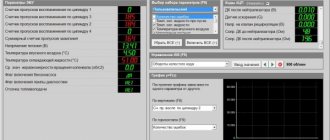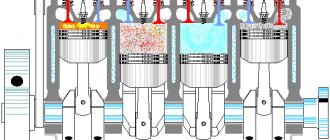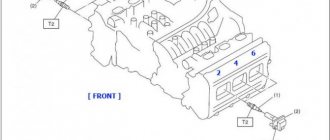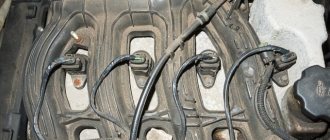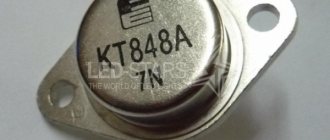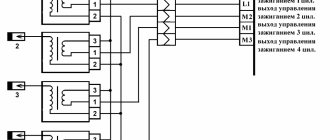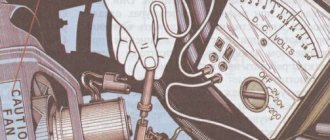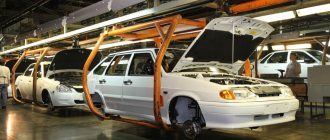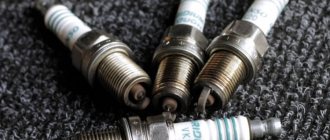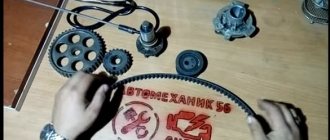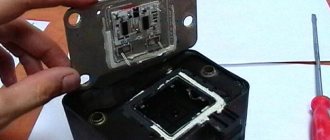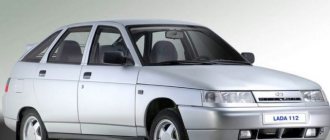1200 rub. for the photo report
We pay for photo reports on car repairs. Earnings from 10,000 rubles/month.
Write:
Error code P0300 indicates a violation of the ignition order , which stands for random multiple misfires of the cylinders ; in English, the diagnostic tool displays: “Random cylinder misfire detection system.” If a misfire is detected in a specific cylinder, then the last digit “P030x” will change to 1, 2, 3, 4 and so on up to 6 or even 12, depending on which particular “pot” the misfire is in. So error P0300 is derived from errors such as P0301, P0302, P0303, P0304. Most often they occur due to a lack of spark, a fuel supply failure or problems with the exhaust gases.
Let's look at the list of possible causes of misfires, why error p0301, error p0302, error p0303, error p0304 or others of this kind appears, the consequences and methods of elimination, in more detail.
Consequences of error P0300
If a misfire occurs in the engine in the exhaust pipe the level of exhaust gas toxicity increases , which, in turn, can also lead to an increase in the temperature in the catalyst, which causes its damage (the honeycombs melt because the temperature exceeds the threshold of 800 °C ). On some cars, in order to reduce the burnout of fuel in the catalytic converter and, consequently, the level of toxicity, the ECM unit monitors the frequency of misfires using crankshaft and camshaft sensors and, in addition, it registers error p0300, signaling a checkengine light can also , in which the gap was discovered. It is worth mentioning that most often, for some reason, the owners of cars such as Lacetti, Matiz, Priora and other injection VAZs, as well as Opel, Nissan, Kia cars, are interested in the reasons for the occurrence of this error.
Troubles when cold - Community "Lada Priora (Lada Priora Club)" on DRIVE2
Hi all! I recently wrote a post about a stuck pump, and so, the valves still had to be changed (( We changed all 16 valves, oil seals, and at the same time the injectors, because two had a burst housing, and the mileage was 111 thousand, the car definitely started to drive more cheerfully .But today I start it and it starts up. And I held it at 2-3 thousand revolutions, it works more or less, I release the pedal - it starts and the check blinks, and then goes out. As a result, I kept it at 2 thousand until 90 degrees, the work leveled off, I released the pedal - that's it normal. And all evening I drove everything was fine. I started it when it was hot, no problems. Right now I decided - let me check. The engine has cooled down. I start it - it troits. First - I determine the cylinder - the second. I change the coils, remove the terminal - it still troits 2. I cleaned the throttle, no changes. I just recently changed the spark plugs. Unfortunately, I don’t have a scanner at hand, but even without it it’s clear that there are misfires in cylinder 2, but here’s why? In theory, if the valves weren’t seated well, it would be misfiring all the time, right? By the way, the hydraulics are rattling alone, have you heard that they can also cause triple noise?
When does error code P0300 pop up?
Note that error code P0300 is recorded by the control unit only when misfires are detected in several cylinders simultaneously , since a misfire in one of them is recorded after two repetitions in a row, and the rotation speed of the CV is important. At idle, the error is stored in memory after 3.5 minutes of engine operation, and at speeds above 2 thousand - a little more than one minute. threshold for registering a DTC in the ECM memory is more than 3.25% of missed flashes per 1000 revolutions. If misfires are detected only in a certain cylinder, then not error P0300 is generated, but another one, with the serial number of the combustion chamber of the internal combustion engine.
Error p0300, p0301, p0302, p0303 and p0304 causes
Unfortunately, the diagnostic tool has not learned to determine the specific cause of the failure and, in this case, misfire in the engine cylinder, but, fortunately, the most likely malfunctions can develop in two directions - either there is nothing to burn , or it is impossible to ignite . Although it is still too early to rejoice at the possible quick search for the cause of error p0300, since it could be:
Cylinder misfires. How to diagnose the cause.
- In the ignition system
- spark plug failure;
- breakdown of a high-voltage wire;
- faulty ignition coil (or module);
- other reasons related to wiring and connectors in the ignition system.
- In the power system
- poor quality fuel;
- clogged injectors;
- heavily contaminated fuel filter;
- low fuel pressure.
The main reasons why error P0300 occurs
How to Troubleshoot or Reset Trouble Code P0303
Some suggested steps to troubleshoot and fix error code P00303:
- Use an OBD scanner to make sure there are no other errors. If they are present, it is recommended to eliminate them first.
- Inspect the looseness of the connectors on the ignition coils or any damage to the wiring. Also look for loose engine ground wires. This may cause random misfires. Tighten or correct if necessary.
- Check the condition of the spark plugs and their wires. Worn and old spark plug wires are common causes of random misfires. Replace spark plugs and wires if necessary.
- It is necessary to measure the fuel pressure. Low pressure can cause intermittent misfire in multiple cylinders. When the pressure is below specification, the engine does not receive the proper amount of fuel and begins to lean the mixture. The fuel pump or pressure regulator may be the source of low pressure.
- Make sure the fuel injectors are working properly and activating. Random misfires may be a sign of faulty or clogged fuel injectors that need to be replaced. Also check that the fuel injector wiring is not damaged and is connected correctly.
- If the ignition and fuel system pass inspection, you can perform an engine compression test and a leak test to see if there are any mechanical problems causing the misfire.
Diagnosis and problem solving
Sometimes, when P0303 is detected, no symptoms are observed. The easiest thing to do in this case is just reset the code and see if it comes back.
If the problem manifests itself in the form of uneven idle or engine jerking, check all wiring and connectors leading to the cylinders. Next, it’s worth checking the spark plugs, wires, and coils.
In some cases, the cause is a failed catalytic converter. If you smell a rotten egg smell in your exhaust, the catalytic converter needs to be replaced. Faulty fuel injectors should also not be overlooked.
Random misfires may be due to lean fuel. This may be due to a vacuum leak in the intake manifold or air flowing past the airflow sensor. And also because of the exhaust gas recirculation valve stuck in the open position.
Recommendations for checking and troubleshooting
The first thing you should check when misfiring is the explosive wires and ignition coils (module), they often turn out to have broken insulation, a break, or an oily surface. We measure the wires with a multimeter (normal resistance is about 4 - 10 kOhm), in resistance mode, but to check individual ignition coils, you just need to swap places with a known working cylinder and clear the errors again. If the code has changed to the number of another cylinder, then the coil is faulty. The ignition module is more complicated; it needs to be checked with a tester.
The second in line are the spark plugs - a damaged electrode, incorrect gap, or oil deposits lead to failure or unstable operation of the spark plug.
Having unscrewed the spark plug for inspection, then what else can be done - measure the compression in the cylinder . Reduced or absent compression leads to insufficient compression, and therefore creates problems with ignition of the mixture.
Clogged fuel injectors provoke interruptions in the supply of fuel to the combustion chamber, but, unfortunately, without a stand it will not be possible to quickly check them. And the only thing that can be recommended in such a situation is to refuel with fuel with a higher octane number, and drive the car for some time at high speeds (4-5 thousand/rev).
A fuel filter that has not been changed for a long time or bad gasoline very often becomes the culprit for the unstable operation of the injectors. Therefore, remember the last time the filter was changed, and at what gas station you filled it with fuel.
A stuck EGR valve or leaks through the intake manifold gasket , which can also cause random misfires, can be difficult to determine on your own, so when doing computer diagnostics, pay attention to such a parameter as long-term fuel correction . It will show how much the ECU compensates for the imbalance in the air/fuel ratio. When this parameter on a particular cylinder differs by more than 10%, this may indicate a vacuum leak or air leak.
More rare cases that cause a violation of the ignition order, such as disrupted valve timing or a violation of the exhaust gas outlet , are controlled by the control unit and, in addition to the P030X code, other errors will appear regarding the catalyst, lambda probe, camshafts.
I hope all these tips will help you not only figure out the cause of the malfunction, but also fix it yourself, without outside help, without spending a ruble, or pay only for a specific part, and not waste money on replacing everything that can fail .
March 20, 2010, 11:03 #1 123
Help with advice! mileage 80 thousand the third cylinder failed, what could it be?
- Posts: 2206
- Lada Priora
On which cars is this problem most common?
The problem with code P0303 can occur on different machines, but there are always statistics on which brands this error occurs more often. Here is a list of some of them:
- Audi (Audi a4, Audi a6)
- BMW (BMW E46)
- Chery (Chery Tiggo)
- Chevrolet (Chevrolet Aveo, Cruz, Orlando, Trailblazer)
- Chrysler (Chrysler Voyager, PT Cruiser)
- Dacia (Dacia Largus)
- Daewoo (Daewoo Gentra, Nexia)
- Dodge (Dodge Caravan, Stratus)
- Fiat
- Ford (Ford Windstar, Mondeo, Fiesta, Figo, Focus, Fusion)
- Honda (Honda Accord, Civic)
- Hyundai (Hyundai Accent, Getz, Santa Fe, Solaris, Tucson, Elantra)
- Infiniti
- Jeep (Jeep Grand Cherokee, Liberty)
- Kia (Kia Rio, Sid, Sportage)
- Lexus (Lexus rx300)
- Mazda (Mazda 3, Mazda 6, Mazda cx7, Tribute, MPV)
- Mercedes
- Mitsubishi (Mitsubishi Galant, Lancer, Space Star, L200)
- Nissan (Nissan Almera, Qashqai, Terrano)
- Opel (Opel Astra, Vectra, Zafira, Corsa, Meriva)
- Peugeot (Peugeot 307, 308)
- Renault (Renault Duster, Logan, Sandero)
- Skoda (Skoda Yeti, Octavia, Fabia)
- Ssangyong
- Subaru (Subaru Outback, Forester)
- Suzuki (Suzuki Grand Vitara)
- Toyota (Toyota Camry, Corolla, Prius, Fielder)
- Volkswagen (Volkswagen Golf, Jetta, Caddy, Passat, Polo Sedan, Touareg, Tiguan)
- Volvo
- VAZ 2110, 2112, 2114, 2115
- Volga Cyber
- Gazelle Business
- Lada Kalina, Largus, Niva, Priora
- UAZ Patriot
With fault code P0303, you can sometimes encounter other errors. The most common ones are: P0016, P0102, P0113, P0171, P0174, P0183, P0203, P0267, P0300, P0301, P0302, P0304, P0305, P0306, P0316, P0363, P0400, P0420, P1303.
Causes of misfire in a cylinder
Let me start with what is a misfire? This definition is usually used to describe a phenomenon in an engine when one of the cylinders accelerates a little slower than the others, which actually disrupts the working process of the engine and the stroke cycle. Often, the consequences of misfire, for example, such as deterioration of the exhaust, are of little interest to anyone. Most car owners are most often concerned that the car practically does not move, constantly “twitches” and cannot cope with the load.
What misfires are is more or less clear, now I propose to understand the reasons for this phenomenon. In fact, there are a lot of such reasons, so I will list the most typical ones.
1. Quality of the air-fuel mixture. Due to poor quality fuel, the injectors can become clogged. In this situation, everything is very simple - first of all, you need to change the gas station or switch to high-octane gasoline. In addition, a lean mixture can often be due to the following faults: pressure regulator, fuel pump or clogged filter.
We are looking for the cause of misfire in the cylinder
Car owners whose cars are equipped with “electronic brains” are a little more fortunate in this matter, since it is possible to use an auto tester. Thanks to the “brains” and testers, you can see error codes, for example, where exactly misfires occur in cylinder 1 or 3.
In addition, using the scanner you can also determine the direction of the search itself. If the scanner showed you code P0204, and you know that this is an injector malfunction. Code P0300 indicates random misfire in all cylinders. Therefore, we can conclude that the air-fuel mixture is deteriorating, which means that the reason may lie in high air suction at the recirculation valve or in low pressure due to a faulty pump.
If a misfire occurs in a car that does not have an electronic assistant, then you will have to look for the cause using “old-fashioned methods.” They begin with checking the electrical equipment located under the hood: spark plugs, explosive wires, after which the compression in the cylinders and the condition of the fuel pump are measured.
If none of the versions are confirmed, there are two options: either continue the search on your own, or go to a service station for help, where they will help you fix the problem for money.
see also
Comments 72
The best water displacer is a couple of liters of alcohol per full tank. and cleaning the injectors doesn't take long. There may be wear on the seat and needle. They write to rub it in with some kind of paste, but it makes no sense. the most reliable thing is to replace it with new ones
The injectors drove less than 10 because it’s strange but in + weather it doesn’t bother
I changed the entire exhaust, there was always an error in the oxygen sensor, I had to flash it. And I couldn’t drive at the “factory” anymore. The factory firmware severely “chokes” the engine.
And also, regarding the injectors, when my engine was running rough, the error was due to misfires in the 2nd cylinder. I removed the fuel rail along with the injectors. I turned on the ignition and the second injector began to sweat. I noticed this a long time ago, then I fixed it and forgot about this problem.
I had the same problem as you. One to one. I suffered for a long time, changed everything, cleaned it, but in the end it always crashes in the morning. The problem was solved very simply by updating the firmware. My brain is Bosch 797+, I uploaded the firmware from Icebreaker B11KSS (LR) v7.4. I forgot about this problem.
How did you come to this conclusion about the firmware? I haven’t had my original one for 2 years now.
I mean, how did you come? I asked for it and it arrived) There are different firmwares. I tried many different firmwares, but it stopped crashing on this firmware from Icebreaker.
Personally, for now I’ll dig in the direction of the valve or injector, but what prompted you to sew?
it's an electrical issue, you have a constant voltage on the coil on cylinder 2, that's why it's bad, I had the same thing, only 3 cylinders, in the end I changed the brains, everything became normal
Priora 126 engine 16kl. Misfire 2 cylinders. While driving, mostly on the highway, the check light comes on and there is no ignition in cylinder 2. I reset the error through elm 327 and it works. I also noticed that when the gas pedal is in the floor before the engine starts to slow down a little, then it’s normal. where to dig? To begin with, I want to change the candles. Misfire in cylinder 2 of Priora.
Similar articles
40 comments on “Misfire in cylinder 2 of Priora. Misfire cylinder 2"
On my 12k engine it was 124, so the diagnostics showed cylinder 1, changed the ignition coil, everything was fine.
Ignition coil, change it
You just have a mysterious breakdown... What is the problem with changing the spark plug in the second cylinder and if that doesn’t help, changing the coil? Of course, there is also an injector as an option
What ECM malfunctions can trigger the misfire diagnostic?
As mentioned above, misfire detection occurs by uneven rotation of the crankshaft. This is an indirect measurement method, it registers the very fact of the presence of increased unevenness, and also identifies a faulty cylinder, but does not indicate the cause (that is, a faulty engine management system component). The presence of codes P0300 - P0304 in the controller error memory requires a thorough diagnosis of the entire control system, as well as the engine itself. Below are the most common faults that trigger the misfire diagnostic. Ignition module. A break or interturn short circuit in one of the coils leads to the fact that high voltage is not supplied to one or a pair of cylinders (1-4 or 2-3). The functionality of the ignition module is checked using a high-voltage spark gap. Spark plug. Incorrect spark gap, moisture, conductive paths, cracks, carbon deposits on the insulator, and leaking spark plugs cause problems with ignition of the air-fuel mixture. There are special stands for checking spark plugs, but the most effective method of checking is replacing them with new ones. High voltage wires. The most common faults are a broken wire (resistance should be in the range of 6-15 kOhm, checked with an ohmmeter) or damaged insulation. Injectors. Sticking of the injector in the open or closed state leads to non-ignition of the air-fuel mixture. In the first case, the spark plugs become wet due to excess fuel. To assess performance, it is necessary to balance the injectors. Another option for injector malfunction is an interturn short circuit in the winding. Throttle position sensor. The cause of the misfire diagnosis may be a throttle position sensor with a worn out resistive layer. A sharp change in the sensor characteristics with minor movements of the gas pedal leads to a sharp change in engine modes, which will cause increased unevenness of the engine. The TPS characteristics can be checked using a diagnostic tool by smoothly pressing the gas pedal and monitoring changes in the sensor signal using the device. Over-lean air-fuel mixture. When the air-fuel mixture is too lean (a>1.20), problems arise with its ignition even with a working ignition system. Overeating can be caused by:
— leakage of the intake system; — a malfunction in the fuel supply system; — low fuel level in the tank; — malfunction of the mass air flow sensor; — malfunction of the oxygen sensor.
Mechanical engine problems. Any mechanical problem with the engine that interferes with gas exchange in the combustion chamber or prevents the crankshaft from rotating smoothly can trigger a misfire diagnostic. Eliminating such faults is the most labor-intensive, as it requires disassembling the engine. In many cases (but not always), the presence of mechanical problems can be judged by changes in compression from cylinder to cylinder.
Damper with ring gear. When the crankshaft position sensor magnetically interacts with the damper ring gear, a signal is generated, from which the controller calculates the current piston position, crankshaft rotation speed, and acceleration. Strong beating of the ring gear, a large angular error in cutting the teeth of the ring (for example, if the damper was made in a home-made manner), as well as a damaged rubber damping layer can lead to erroneous calculations of acceleration and, as a result, to false recognition of misfires. Coolant. The ingress of coolant into the cylinders will lead to disruption of mixture formation, and therefore to non-ignition of the air-fuel mixture.
As can be seen from the above, there can be many reasons why the misfire diagnosis is triggered; another thing is that some malfunctions occur frequently, while others are extremely rare. Detailed methods for troubleshooting are given in the maintenance manuals for VAZ vehicles, so we will not dwell on them in detail. I would just like to draw attention to one point. If you are faced with the task of finding the reasons for the appearance of codes P0300 - P0304, then the first thing you need to check is how the engine operates at the time the codes are registered. In other words, the engine “troubles” (for example, when changing the gas) or operates evenly. The direction of the search depends on this. A “crooked” damper, an over-lean mixture (very often), or a jammed water pump do not lead to deviations in engine operation that can be determined by ear. On the other hand, failure of spark plugs, ignition module, high-voltage wires, injectors, and reduced cylinder compression significantly affect engine performance.
